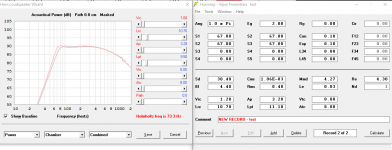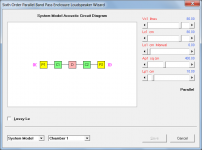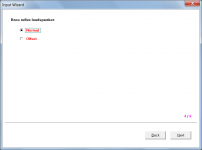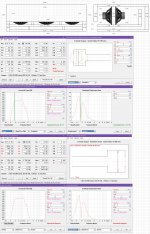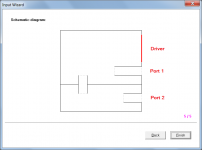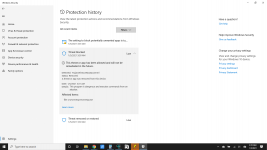First I would like to say thanks to David, without whom this fantastic beast would not be possible.
Now a noob question for someone who wants to use Hornresp for something WELL below it's capability! Hornresp is big and powerful and all, but can be daunting for use trying to do something as simple as a ported box!
Driver is Dayton ND91-4
My box internal dimensions:
front baffle: 5.25" H x 3.5" W
Depth: 4.0" (1.2 liter box)
Depth: 4.6" (1.4 liter box)
could one of you geniuses take a quick look and make sure I havent done something stupid? As I understand it I did a rear chamber port, and then I made the 'horn' length tiny. I think that's how it's supposed to work (I'm slowly making my way through this 1000 page novel!
Now a noob question for someone who wants to use Hornresp for something WELL below it's capability! Hornresp is big and powerful and all, but can be daunting for use trying to do something as simple as a ported box!
Driver is Dayton ND91-4
My box internal dimensions:
front baffle: 5.25" H x 3.5" W
Depth: 4.0" (1.2 liter box)
Depth: 4.6" (1.4 liter box)
could one of you geniuses take a quick look and make sure I havent done something stupid? As I understand it I did a rear chamber port, and then I made the 'horn' length tiny. I think that's how it's supposed to work (I'm slowly making my way through this 1000 page novel!
Attachments
Last edited:
It's just another way of representing the solid radiation angle, and hopefully helps to make clear why the beam width of the directivity pattern in 0.5 Pi space, for example, is confined to 83 degrees as shown in Attachment 1.
Attachment 2 shows the radiation from a point source in a corner. The surface area of the radiating wavefront will be 0.5 x Pi m^2 when r, the distance from the source, is 1 metre.
When the included angle at the apex of the spherical sector shown in Attachments 3 and 4 is 83 degrees (to the nearest whole number) then the area of the spherical cap at a radius of 1 metre will also be 0.5 x Pi m^2.
I can't see how 🙂.
Sorry if i get confusing, i have a gravitation towards a ‘big bang’ box idea of sorts. Where the sound originates in the enter and we grab from different parts in the expansion as a 4 pi r ^2 shapes changes in phase. like a qw transmissionline is venting ‘aged’ sound at 90 degrees from zero of its full vented sound(vs direct radiator), a compound horn seems to make another degree in phase for the same length traveled , minus the opposite created by the other path to its vent(no direct radiator).. at 240 cm for example, 80 cm will yield the best result as seen at the 35.8, 71.6,107.4,179, 214hz, and so on.
If instead you place that compound path on the end if the existing qw pipe, following a tapped entry to keep things moving, the phase integrates much nicer but you suffer the ‘flip’ at the second driver location and must deal with that.
Same occurs in sharp folding, but we are not aware of it unless we break it down to see(or get a close guess). if i fold a compound qw pipe up so that phase isnt isnt an issue so much as the actual angle were trying to make cohesive is in the arc of 30 or 45 or 60 degrees instead of 90, then... i dunno, still trying to create this in sim vs real, but the sound is (so far) very unique and transients in music either suffer or benefit, still trying to decide on what ‘angle’ in what part of the ‘two’ bandwidths is really ‘aged’ in folding, and where im trying to manipulate from after each LP filter segment occurs(a fold).
🙂 amazing way to look at so many things.... the entire universe can relate to certain elements inside Horn response. Its nit just a speaker learning Tool, its an A/C current guide, a charged particle interaction tool, a propogation of a expanding shape and its spread in a boundary condition(a virus?) and or a piece of information...
ironic. but in many ways these types of tools are incredibly valuable to more than just the sound maybe, maybe they are almost as accurate as they can be to represent how we can screw up a predicted outcome by not feeding life the correct input info. Life is offset, inverted in phase and propagating all while we are aging. maybe thats why horn response is so exciting and people keep digging deeper and deeper. were all getting closer to an understanding of sorts. Sooner or later we will find harmony? Or chaos? Or a decent compromise in harmonics. But not yet, its simply not that ‘easy’??? I dunno, but something is hiding inside the way to design a speaker and it very well could be a decent way to remind us all of how things work in not only sound, electromagnetic waves? somewhat too?
whats phase at Fb, the mid band and the Fb/3 at the top? Then what is it in a seperate opposite path from the other side of the cone and why its advantageous to make them overlap at one third versus one half or 100% the length of the ‘other? A base reflex will yield a 180 at Fb and a straight qw pipe with a closed end will join it in harmonics at that phase too(is 90 plus 90degrees as 240 ccm length and bounced back from the dead end?? 180? Well, I get a weird TL thats bass heavy in its bias? I think, in reality im confused because its folded and the folds interrupt something? i think they cause the opposite to swing through to another frequency in music and the standing waves spit out are goofy too?
Hard to ‘hear’ im trying to pic it apart to see but i cant see what the dsp makes me hear🙂
i make charts with all the frequencies now and use two folds. no more. the mic and plotting invidual tones generated, bot just a sweep or pink. Its different. I get to excited and burn up voice coils or need to get a better amp, because these things clip at the most acoustically relevant spots! And at the harmonic intervals if 240 cm i place them... or even try to offset them. Thats when i see the missing secret inside horn response. but also a way to a pattern to still ‘predict it. Folding?
It works! and i built an idea into a box but a friend did as well. He jumped the gun andscrewedd it up. But he fixed it using the same ideas in reverse(mini absorbers of the same path offset).??? Crazy, but now the idea is real. Its just very hard to show, prove, and share so itll help others.
And bany steps not leap frogging! i must be patient! 🙂
Last edited:
First I would like to say thanks to David, without whom this fantastic beast would not be possible.
Now a noob question for someone who wants to use Hornresp for something WELL below it's capability! Hornresp is big and powerful and all, but can be daunting for use trying to do something as simple as a ported box!
Driver is Dayton ND91-4
My box internal dimensions:
front baffle: 5.25" H x 3.5" W
Depth: 4.0" (1.2 liter box)
Depth: 4.6" (1.4 liter box)
could one of you geniuses take a quick look and make sure I havent done something stupid? As I understand it I did a rear chamber port, and then I made the 'horn' length tiny. I think that's how it's supposed to work (I'm slowly making my way through this 1000 page novel!
The only parts needed are the VRC/LRC(box chamber), and Ap/Lp(chamber vent). The ‘s’ and ‘l’ at the top are on the face of the driver outside the box and not part of it unless doing something different and ‘complicated’ 🙂 or avoiding that baffle ?
In in other words, i think your doing it right, if LRC is the largest Basic dimension in the box? The port is very small and short too. If that's real, then there you go. 3cm2 port is 9 cm long.
Atc needs a Vtc if wanted a front shape to be inckuded?
Last edited:
Thanks for the input. I'd like to include the effects of the baffle shape, and the internal box shape as well if I cab, but am not quite seeing how to do that. The big thing is I wanted to verify the box volume and port alignment and compare to Winisd, which BTW, gave me a much different (larger) optimum box size.
I double clicked on the variables, but it's not always east to see what the program is looking for.
This is a 3 1/2" driver so small box and there's not much room for a port (ID 20 mm 3/4" schedule 40 PVC). I tried using the next size PVC pie size for the port but the internal box is only 5.25 inches tall so not a lot of room for a long port. When I simulated a passive radiator (either 2X90 or 1X105), there was seamingly less bass. than the ported version. I could very easily be doing something wrong...
I double clicked on the variables, but it's not always east to see what the program is looking for.
This is a 3 1/2" driver so small box and there's not much room for a port (ID 20 mm 3/4" schedule 40 PVC). I tried using the next size PVC pie size for the port but the internal box is only 5.25 inches tall so not a lot of room for a long port. When I simulated a passive radiator (either 2X90 or 1X105), there was seamingly less bass. than the ported version. I could very easily be doing something wrong...
Hi David, I'm running into an issue importing BOXPLAN-created sim files of stepped THs into Hornresp. The format of the file looks correct, but Hornresp "Input Parameters" page does not show the sim as a stepped TH.
The BOXPLAN workbook in question is BOXPLAN-PARAC, and it's available from the link below. Please use the "Export (TH)" option to create the sim file.
The Subwoofer DIY Page - Horn Folding
Once we get that sorted, perhaps we can delve further into why simming the box as a BP6P rather than a TH seems to produce different results... 🙂
The BOXPLAN workbook in question is BOXPLAN-PARAC, and it's available from the link below. Please use the "Export (TH)" option to create the sim file.
The Subwoofer DIY Page - Horn Folding
Once we get that sorted, perhaps we can delve further into why simming the box as a BP6P rather than a TH seems to produce different results... 🙂
BTW - it seems to be something with the BOXPLAN import routine in Hornresp. If I export a valid stepped TH file, change the ID from "BOXPLAN" to "48.20" and then try to import it, it's not imported as a stepped TH.
1. Include Ang as an option in the Bandpass Wizard.
2. Include an option to set Path for the BP6P model.
Ang and Path sliders will be added in the next update.
Ang will apply to all models, Path will apply to BP6P, BPA, BPC and DBR models.
I'm running into an issue importing BOXPLAN-created sim files of stepped THs into Hornresp.
Will modify the code to enable this to happen, as from the next update.
simming the box as a BP6P rather than a TH seems to produce different results
That's because the two systems are different 🙂.
Try comparing the acoustic circuit diagrams - the one for BP6P is attached.
Attachments
can be daunting for use trying to do something as simple as a ported box!
If not sure how to specify a particular design, try using the Input Wizard to generate a "template", and then adjust the parameter values as necessary. The Input Wizard can be accessed from under the Input Parameters window Help menu.
Attachments
Lost designs
Hi,
Now I am here again. Trying to fit a ML-TL in a already built Rauna concrete cabinet.
Mixing different drivers and "save" from Loudspeaker wizard, and answer Yes when it ask me if i want to save the records when starting a new design. Despite that nothing is saved. What do I do wrong??????? I mean, how could I fail to do something as simple as save a design????😀
Hi,
Now I am here again. Trying to fit a ML-TL in a already built Rauna concrete cabinet.
Mixing different drivers and "save" from Loudspeaker wizard, and answer Yes when it ask me if i want to save the records when starting a new design. Despite that nothing is saved. What do I do wrong??????? I mean, how could I fail to do something as simple as save a design????😀
That's because the two systems are different 🙂.
Try comparing the acoustic circuit diagrams - the one for BP6P is attached.
So in BP6p the ‘path’ is always vent to vent total, including all ‘L’ designations given in the 4 pair, driver splits the paired. No offset, no fold, straight math, and result. And then can be used to compare such ‘alterations’ by using the compound horn or CH, CH1 to ‘look’?
In a way that both OD and OD 1 can show something vs Nd as a TL shape?
I guess the brain teaser is: what happens from
The ‘direct radiator’ to the ‘vent’ if path is 0.01cm in OD, Lpt and path is 0.01 in OD ‘clo’, and L45 in TH is 0.01cm? Or CH at two seperate lengths from the driver, that started as zero and 180 ‘out of phase’ then spun to 90 and (?) ‘in phase so to speak-and traveled ‘path’ as the hypotenuse of it, at 1.414x to the listener? assume 240cm and 80 cm for the CH split. path at 80,120cm or a few lengths end up Making a cycle? But its a bit tricky to drop
Yhat idea into offset, or tapped or compounded as the ‘cycle’ is in relation to the otherside?
Vs path of (1/3?) of the tuning length (in qw) and all while sitting at 1meter on center.
I guess ‘path is ‘deminishing’ and the others are inside the cabinet and so theres no deminish by distance, except in a large flare rate, only cancel/ interfere?
If that makes sense, i tried 😀
Last edited:
You cannot have a vent that is less than the thickness of wood used to build the enclosure. The shortest vent I use is 0.75 inches or 1.905 centimeters.
Note the use of 1.91cm in both the BP6P and CH models.
Also, I use 1.905cm x Sd to get Vtc...driver mounting hole(s).
Note the use of 1.91cm in both the BP6P and CH models.
Also, I use 1.905cm x Sd to get Vtc...driver mounting hole(s).
Attachments
Last edited:
But a standing wave goes straight to the very end and returns. No offset, no centered thru a turn, etc end to end. A vector flipping at each.
So if you make an assumption based on the standing waves predicted and a result from folding @ those intervals as harmonics, its a tight fit and a compound horn at 240/80cm is like an offset driver qw pipe at 120/120/80/0.01cm(in TH) no path, no extras, straight up.(reality and the hard details of it to be dealt with after). But dead nuts on phase at the point of offset if the correct csa is used(tricky but a small Vas and good motor-force makes a lot of stuff easier).
Trickier then are other things like a qw pipe split in the middle by a tapped driver at start and midway: driver entry/120cm/fold/120/tapped entry/120cm/fold/ 120cm/exit expand each time you changebetween those and itll go (but cant sim that fold to see). and 80cm or 90,100,110, 150,etc can be that 120cm instead? But that used tapped driver to half of halfwave of the full sinewave ? Is that the theortetical end of the univetse?
😱😀 i dunno, i need a fold to create the east and west hemispheres with a north and south pole. Phase as 0 - 180 poles and east west is the day to night. 2pi or 4 in 1/2 rotations as cycle? Or is it orbiting of something? Lunar or solar?
David sees the winter night star as we would see in an eclipse during the day. We see that night in winter the same, but if we really looked closely, we could see they shifted slightly. theres an offset. And its the universe verses earth perspective as thru time as we all expand ? Or oscillate? i dunno, but the story a sound wave can tell is crazy!
So if you make an assumption based on the standing waves predicted and a result from folding @ those intervals as harmonics, its a tight fit and a compound horn at 240/80cm is like an offset driver qw pipe at 120/120/80/0.01cm(in TH) no path, no extras, straight up.(reality and the hard details of it to be dealt with after). But dead nuts on phase at the point of offset if the correct csa is used(tricky but a small Vas and good motor-force makes a lot of stuff easier).
Trickier then are other things like a qw pipe split in the middle by a tapped driver at start and midway: driver entry/120cm/fold/120/tapped entry/120cm/fold/ 120cm/exit expand each time you changebetween those and itll go (but cant sim that fold to see). and 80cm or 90,100,110, 150,etc can be that 120cm instead? But that used tapped driver to half of halfwave of the full sinewave ? Is that the theortetical end of the univetse?
😱😀 i dunno, i need a fold to create the east and west hemispheres with a north and south pole. Phase as 0 - 180 poles and east west is the day to night. 2pi or 4 in 1/2 rotations as cycle? Or is it orbiting of something? Lunar or solar?
David sees the winter night star as we would see in an eclipse during the day. We see that night in winter the same, but if we really looked closely, we could see they shifted slightly. theres an offset. And its the universe verses earth perspective as thru time as we all expand ? Or oscillate? i dunno, but the story a sound wave can tell is crazy!
So in BP6p the ‘path’ is always vent to vent total, including all ‘L’ designations given in the 4 pair, driver splits the paired.
The 'Path' parameter value for a BP6P loudspeaker is the length of the shortest acoustic path between the centres of the two port exits (the sound outputs are assumed to be point sources), as shown in the attachment. Currently the two outputs are assumed to be co-located, ie. Path = 0 cm. This will be changed in the next update to allow non-zero Path values to be specified.
To calculate the combined power output, the pressures, phases and physical separation of the two sources need to be known. For the purpose of the exercise, the loudspeaker enclosure itself can be considered to be "invisible". We are only interested in the straight-line distance between the two sound output point sources.
Attachments
Mixing different drivers and "save" from Loudspeaker wizard, and answer Yes when it ask me if i want to save the records when starting a new design.
Just to clarify, is your sequence of events as follows?
1. Select record.
2. Click Edit button.
3. Paste driver from database.
4. Open loudspeaker wizard.
5. Change slider settings in wizard.
6. Save changes when exiting wizard.
7. Save changes when exiting record.
If not, how does the sequence differ?
Include an option to set Path for the BP6P model
Hi Brian,
In addition to BP6P, BPA, BPC and DBR, I am now thinking about the possibility of also including ABC (see attachment).
ABC would have three options:
1. Path between driver and co-located port 1 & port 2.
2. Path between port 1 and co-located driver & port 2.
3. Path between port 2 and co-located driver & port 1.
Option 1 would be the default, with the other two selectable, but reverting to the default on the opening of a new record.
What do you think, despite the co-location constraint on two of the outputs, would this additional functionality be worth including?
Kind regards,
David
Attachments
hornresp got flagged by windows today as a virus
Unfortunately, false positives seem to occur quite often - particularly with Windows 10. It all depends on the anti-virus software being used.
Rest assured, Hornresp is perfectly safe 🙂.
Path between driver and co-located port 1 & port 2.
The above description is a little ambiguous, and could possibly be interpreted two different ways.
Just to clarify - it is port 1 and port 2 that are co-located, not the driver and port 1.
- Home
- Loudspeakers
- Subwoofers
- Hornresp
